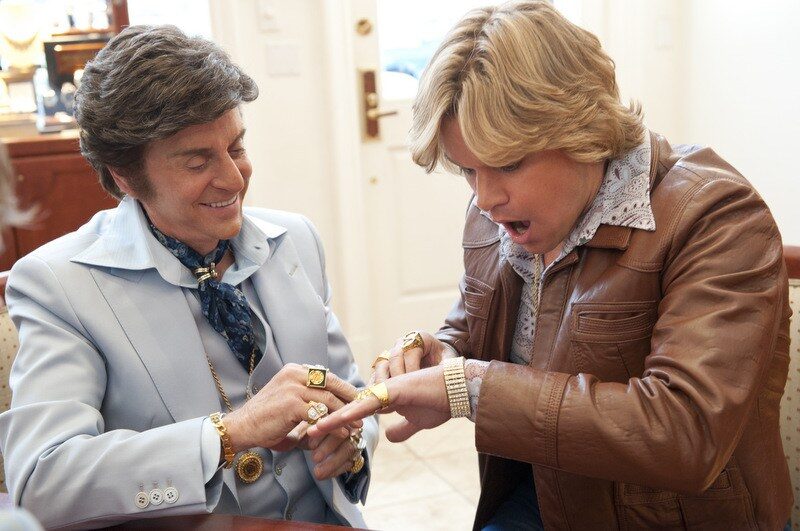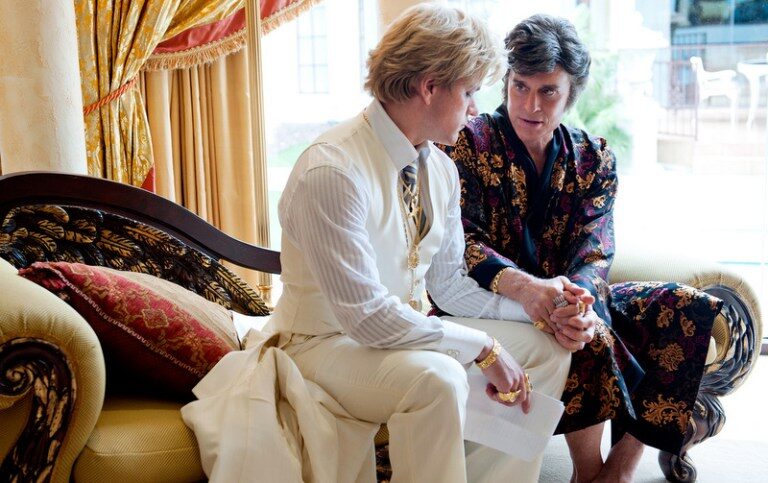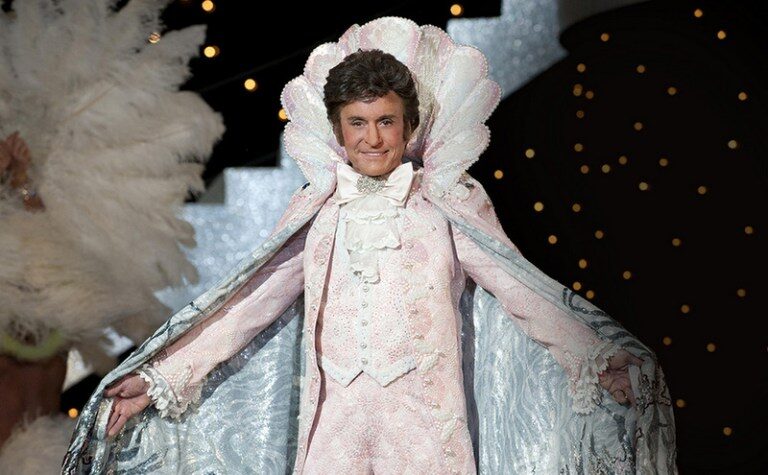Behind the Candelabra: Wearing Liberace On Stage and Off | Clothes on Film

For all involved, Behind the Candelabra is a tremendous achievement: directing, acting, production design and especially costume. Liberace’s stage outfits are recreated faithfully, all the pearls, bugle beads and sequins you would expect. But even more impressive is seeing him at home behind closed doors. Liberace’s (Michael Douglas) life with young Scott Thorson (Matt Damon) is a believable banquet of highs and lows. With every gaudy golden hit there is the inevitable comedown of botched plastic surgery and seedy depravity. This is what Behind the Candelabra is about; the man away from the glitter. He had it all and wanted more. Liberace was the gay Gatsby.
Due to Behind the Candelabra not being released theatrically in the U.S., it is ineligible for the 2014 Academy Awards. This is crying shame for many who put in their best work on the film, but for costume designer Ellen Mirojnick most of all. Short of Coleen Atwood completing a four hour version of Cleopatra, Mirojnick would have deservedly walked away with the big prize. To really understand her intense process for Behind the Candelabra, read the excellent interview she undertook with fellow costume designer Kristin M. Burke HERE – it leaves no (rhine)stone unturned. One very interesting point that jumps out of their discussion was Mirojnick admitting that, ‘costume was not necessarily what was but what should be’. First and foremost she told director Steven Soderbergh’s story, not Liberace’s.
Matt Damon as Scott Thorson and Michael Douglas as Liberace. Costume designer Ellen Mirojnick admits she ‘really went to town on the caftans’.
Not to imply Behind the Candelabra isn’t teeming with painstaking period detail, because it is, only that there was neither time nor budget to be completely accurate in this aspect. Period costume must bow to the will of the production, and this can be for a variety of reasons. With Jenny Beavan’s work on The King’s Speech (2011) for example, she had to placate star Colin Firth who didn’t want a suit jacket under his topcoat so he would look slimmer. It did not ruin his silhouette, though for those who knew the era it was noticeable. Likewise Joanna Johnston’s fastidious Civil War recreations for Lincoln stopped short of making Sally Field’s gloves so tight they practically cut off her bloodstream. Field did put on some weight for her role as Mary Todd, even if she did not come close to her subject’s true bulk. Aesthetically or otherwise we need to believe the era and the people that live within it. Yet, movie making is not documentary making.
Seeing Liberace and Scott during their private time is illuminating (literally – everything around them is so bright). Ellen Mirojnick researched this aspect as much as possible, although most photographic evidence would have been posed-for magazine spreads. To understand how both men lived away from the cameras she had to consider the very specific time period, 1977 through 1982 and, just as much as possible, step into their shoes. Liberace wore incredibly heavy stage costumes, but was also known for his love of caftans and dressing gowns – this was his ‘informal’. Liberace’s appearance remains fairly stable throughout the film. Scott on the other hand goes through a transition as he assimilates more and more of his sugar daddy. He arrives at Liberace’s house in double denim reflecting his ranch upbringing, then on to sequin trunks as he becomes comfortable living the life. Soon he puts on weight in sloppy shorts and a varsity jacket. Eventually it’s polyester suits and flashy shirts as the diet pills and cocaine takes hold (echoing what a debauched place he was in at the time), before finally he is left alone and poor in a shapeless v-neck sweater and jeans.
Douglas wearing Liberace’s ‘King Neptune’ stage costume as recreated for Behind the Candelabra. Due to time and budget, concessions needed to be made with the ensemble such as less detail and appliqué for the lining – which was just as extravagant as the exterior.
Scott’s mini-me is scary enough, but when Rob Lowe’s unscrupulous plastic surgeon Dr. Jack Startz swaggers on screen, not to mention an unrecognisable Debbie Reynolds as Mama Liberace, the result is extremely disconcerting. Soderbergh was not stunt casting and Mirojnick was not playing dress-up, but the nature of the era was overkill. Everything had to be too much, too wide, too fussy and too loud. Liberace lived for an audience. If he were born poor and talentless he would have basically been Scott, however money and fame brought enough power to indulge his every fantasy. His daywear and jewellery had to be that bit more exaggerated than everyone else’s; a scalloped placket shirt or safari suit with sawtooth style pockets, even black funeral attire with red lining – there needed to be something to set him apart. The man we see in Behind the Candelabra is probably a fair recreation of the man who convinced the world (during the 1950s/60’s anyway) that he was not homosexual. This man would also likely have disgusted Liberace himself, as under all the wealth and flash he was dreadfully insecure.
Ellen Mirojnick has created an all-you-can-eat costume buffet with Behind the Candelabra. If the subject was a gift, she has not shied away from the responsibility of dressing him and his world absolutely spot-on. As much fun as it is lapping up the fabulousness, if for one second we do not believe Douglas’ Liberace actually exists – that he could not or would not have worn those clothes – then the whole exercise has been a waste of time. Come for the spectacular and meticulously beautiful stage costumes (the final one in particular) and then stay for the floor length caftans and gold slippers.
Behind the Candelabra was shown on HBO in the U.S. on 26th May and will be released at cinemas in the UK on 7th June.
© 2013 – 2014, Lord Christopher Laverty.

